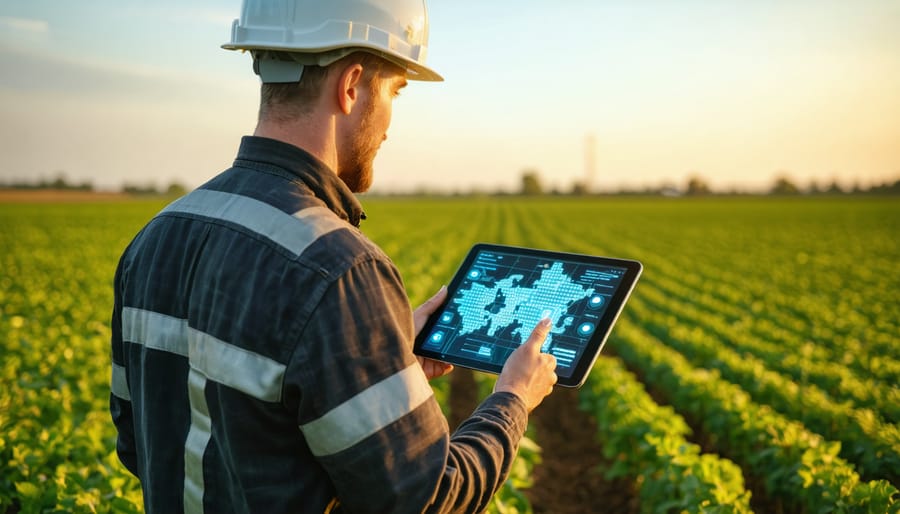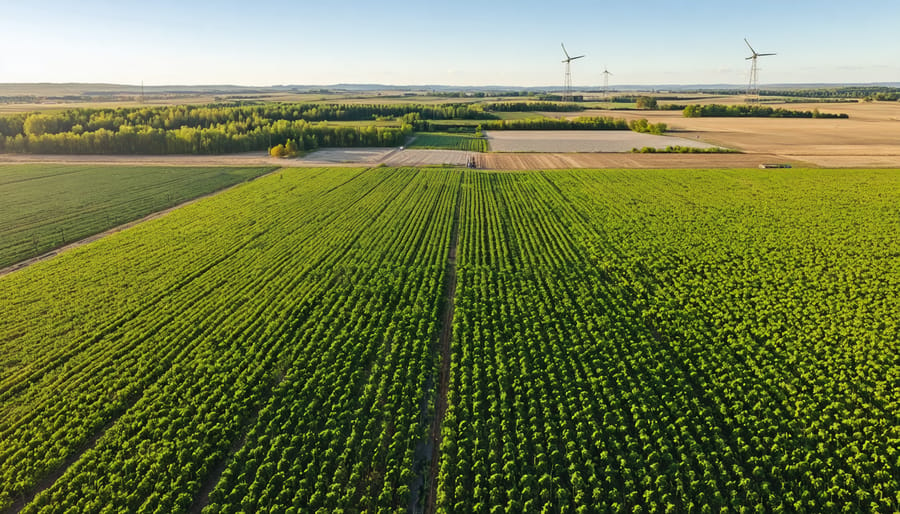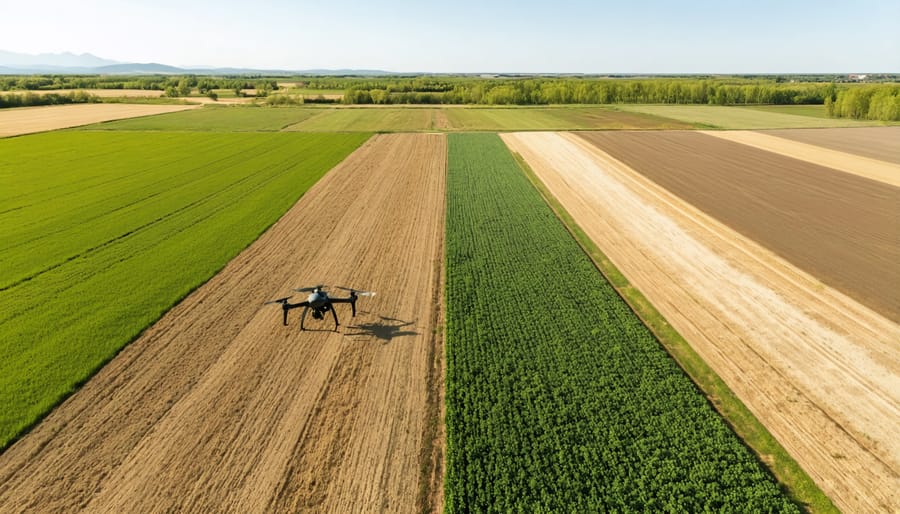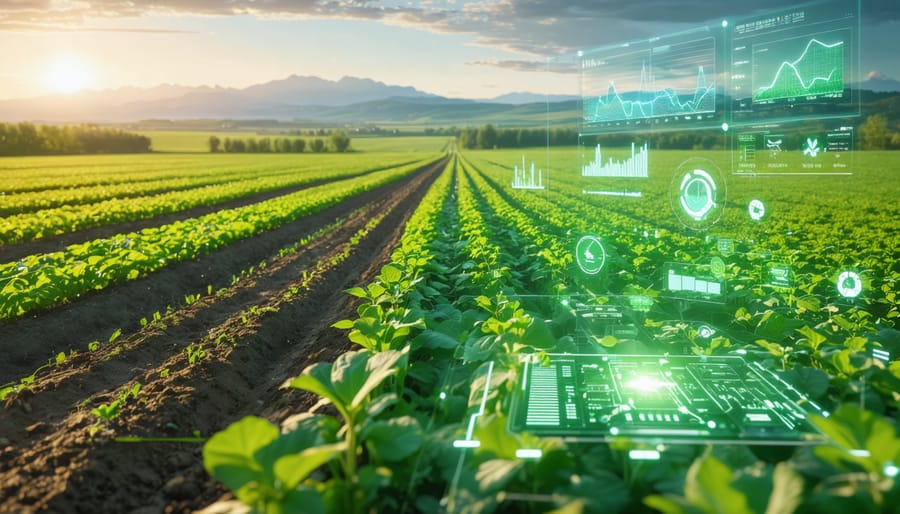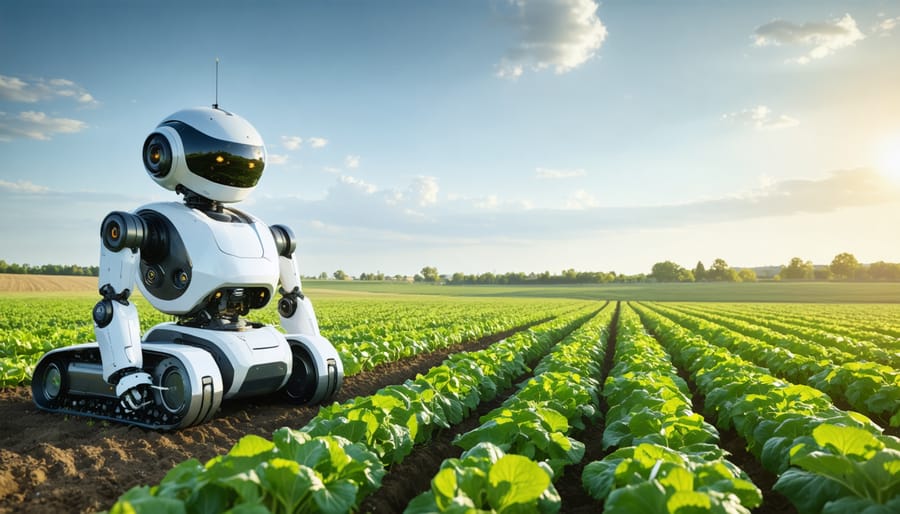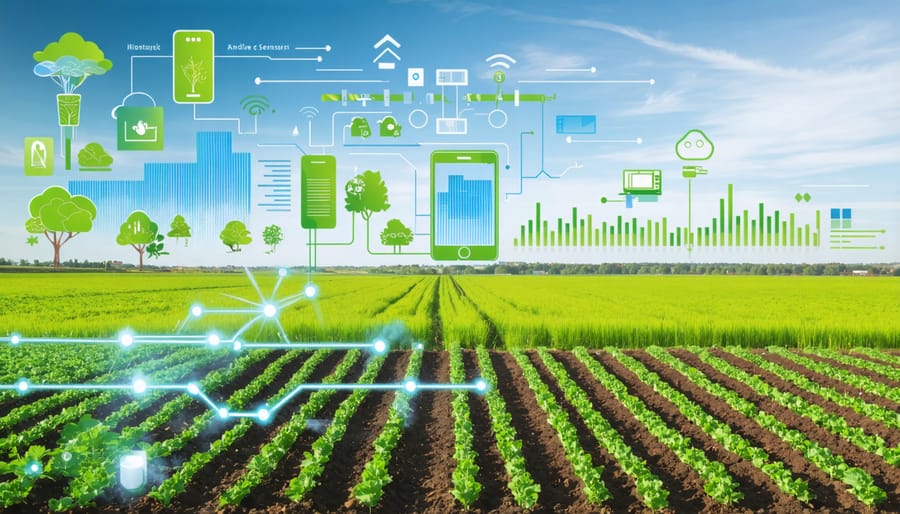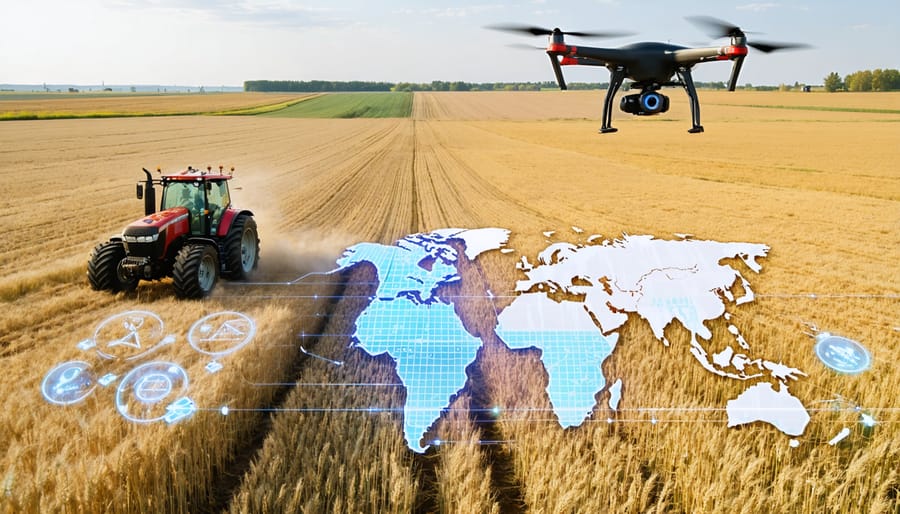# Digital Twin Simulation for Organic Farming: Your Virtual Farm Awaits
Imagine testing your crop rotation strategy, comparing cover crop varieties, or troubleshooting irrigation issues—all before breaking ground. Digital twin simulation creates a virtual replica of your farm operation, allowing you to experiment with management decisions in real-time without risking actual yields or soil health.
This technology, once exclusive to aerospace and manufacturing, is now transforming how Canadian organic farmers plan and optimize their operations. A digital twin uses data from your fields—soil sensors, weather stations, yield monitors, and historical records—to build a dynamic computer model that mirrors your farm’s unique conditions. As conditions change in your physical fields, the digital version updates accordingly, giving you a living laboratory for decision-making.
For organic producers facing the complexities of managing soil fertility without synthetic inputs, balancing pest pressures through ecosystem approaches, and meeting strict certification requirements, digital twins offer a powerful planning tool. Alberta farmers are already using simplified versions to model the impact of different seeding dates on crop maturity before frost, predict water requirements for irrigation scheduling, and visualize how soil amendments will affect long-term fertility.
The technology isn’t as intimidating as it sounds. You don’t need a computer science degree—basic farm management software skills and willingness to collect field data are sufficient starting points. While large-scale operations were early adopters, accessible platforms are emerging for mid-sized farms, with some costing less than a new precision planter.
This article demystifies digital twin simulation for organic operations, exploring practical applications relevant to Canadian growing conditions, realistic implementation requirements, and honest limitations you should understand before investing time and resources.
What Is a Digital Twin (In Plain English)
Think of a digital twin as creating a virtual copy of your farm—like having a test field where you can try out different decisions before committing to them in real life. It’s essentially a computer model that mirrors what’s happening on your actual land, fed by real data from your operation.
Here’s how it works in practice: sensors in your soil track moisture levels and nutrient content. Your weather station records temperature, precipitation, and wind patterns. You input information about your crop rotations, planting dates, and field observations. All this data flows into software that creates a living, breathing digital version of your farm. This virtual farm behaves like your real one, allowing you to simulate “what if” scenarios.
Want to know what might happen if you delay seeding by a week? Run it through your digital twin. Curious whether adding cover crops to a particular field will improve your soil health metrics by harvest? The simulation can project likely outcomes based on your specific conditions and historical patterns.
This isn’t science fiction—it’s an extension of precision agriculture technology that’s already being tested on Canadian farms. Several Alberta producers are working with researchers to develop digital twins of their operations, particularly for managing complex organic rotations and predicting pest pressure without synthetic inputs.
The key difference from basic farm management software? Digital twins actively simulate future scenarios using your real-time data, rather than just recording what’s already happened. Think of it as the difference between checking your rearview mirror and having GPS navigation that shows you multiple route options ahead.
The technology is still emerging, and you don’t need to be a computer programmer to benefit from it. As it becomes more accessible, digital twins could become valuable decision-making tools, especially for organic operations where the margin for error is tighter and recovery from poor decisions takes longer.

Why Organic Farmers Should Pay Attention Now
Testing Cover Crop Combinations Before Planting
Before committing to seed purchases and planting schedules, digital twin technology lets you test various cover crop combinations virtually using your farm’s specific data. Think of it as running multiple growing seasons in a matter of hours rather than years.
A digital twin can simulate how a hairy vetch and winter rye combination might perform on your clay-loam soil compared to a clover-oat mix, factoring in your typical rainfall patterns and frost dates. The system analyzes nitrogen fixation rates, biomass production, weed suppression effectiveness, and termination timing—all before you invest a single dollar in seed.
Alberta farmer James Chen used digital twin simulations to evaluate five different cover crop scenarios for his transition acres. “The simulation showed that my initial choice would have tied up too much nitrogen during spring thaw,” he explains. “I switched to the recommended blend and saved both time and money by avoiding that costly mistake.”
This approach is particularly valuable when you’re introducing cover crops to fields with varying soil types or testing species you haven’t grown before, giving you confidence based on data rather than guesswork.

Predicting Pest Pressure and Natural Control Timing
Digital twin technology enables you to predict pest outbreaks and beneficial insect activity with remarkable accuracy. By modeling pest lifecycles, population dynamics, and natural predator behaviour based on real-time weather data and field conditions, these simulations help you anticipate problems before they escalate. For instance, a digital twin can track degree days to predict when pests reach vulnerable life stages, while simultaneously modeling beneficial insect populations to identify optimal intervention windows.
This predictive capability means you can deploy natural pest control strategies exactly when they’ll be most effective. Alberta farmers testing these systems report timing trap crops and beneficial insect releases with precision previously impossible through observation alone. The simulation runs multiple scenarios—varying temperatures, humidity levels, and field conditions—to forecast when your natural control methods will have maximum impact. Rather than reactive spraying, you’re making informed decisions about when to introduce ladybugs, deploy pheromone traps, or adjust habitat to support native beneficial species, all while the pest pressure remains manageable through organic means.
Real Data, Real Farms: A Canadian Perspective
Digital twin technology is making its way from concept to reality on Canadian farms, with several pioneering operations already testing these systems in conditions familiar to many of you.
At the University of Alberta’s research stations, agricultural engineers have been working with barley and canola producers across the prairies since 2021 to develop farm-specific digital twins. Dr. Sarah Chen, who leads the precision agriculture lab, explains the practical approach: “We’re not building complex simulations that require a computer science degree to understand. We’re creating digital models that answer the questions farmers actually ask—when should I seed, how will this weather pattern affect my crop, what happens if I adjust my irrigation schedule?”
One notable pilot involves a 2,000-hectare organic grain operation near Lethbridge. The farm uses sensors monitoring soil moisture, temperature, and nutrient levels across different field zones. This data feeds into a digital twin that helps predict optimal timing for cultivation and seeding—critical decisions for organic producers who can’t rely on synthetic inputs to correct mistakes. “Last season, the model helped us delay seeding by three days based on soil temperature predictions,” the farm manager shared. “That decision alone improved our germination rates by 15 percent compared to our traditional schedule.”
In Saskatchewan, a cluster of organic pulse growers participated in a 2023 Agriculture and Agri-Food Canada project testing digital twins for pest management. By modeling crop growth stages, weather conditions, and historical pest pressure, the system provides weekly risk assessments. “It’s like having an agronomist constantly watching your fields,” notes Dr. James Morrison, the project lead. “For organic operations where preventive strategies matter most, this kind of predictive capability changes your entire management approach.”
The Manitoba Organic Alliance has also partnered with tech developers to create accessible digital twin frameworks specifically for smaller-scale operations. Their focus is on livestock integration—modeling how rotational grazing patterns affect soil health and crop productivity over multiple seasons.
What stands out in these Canadian projects is their emphasis on practical application rather than technological showmanship. The goal isn’t perfect prediction but better-informed decisions. As Dr. Chen puts it: “A digital twin doesn’t replace your experience and knowledge of your land. It gives you another tool to test your ideas before committing resources—especially valuable when those resources are limited and mistakes are costly.”
These early adopters report that the learning curve is real but manageable, particularly when working with researchers who understand farming realities.
What You Actually Need to Get Started
The Data Collection Foundation
Here’s the good news: you’re likely already collecting much of the data needed for digital twin simulation. The foundation rests on three main information streams that most Canadian farmers already track to some degree.
First, soil data forms the bedrock. Basic soil tests showing pH levels, organic matter content, nutrient profiles (nitrogen, phosphorus, potassium), and soil texture provide essential baseline information. Modern soil monitoring tools can enhance this data collection, but even annual lab tests offer valuable input.
Second, historical yield records—whether stored in notebooks, spreadsheets, or farm management software—help the system understand your land’s performance patterns. Include details about crop varieties, planting dates, and harvest quantities measured in tonnes per hectare.
Third, weather information is crucial. Many Alberta farmers already monitor precipitation (measured in millimetres), temperature ranges, frost dates, and growing degree days. Local weather station data can supplement your on-farm records.
The key isn’t perfection—it’s consistency. Even two to three years of basic records provide enough foundation to begin building a useful digital twin of your operation.
Technology Options for Different Farm Sizes
Digital twin technology doesn’t require a massive investment to get started. For smaller operations (under 50 acres), begin with smartphone-based monitoring apps paired with farm management software that track weather patterns, soil conditions, and basic crop development. These free or low-cost tools can integrate photos and manual observations to create simple predictive models.
Mid-sized farms (50-500 acres) benefit from adding affordable soil moisture sensors (starting around $200-500) and basic weather stations ($300-800) that automatically feed data into visualization platforms. Several Alberta producers have successfully implemented this tier with under $3,000 initial investment.
Larger operations (500+ acres) can justify sophisticated sensor networks, drone imagery integration, and AI-powered analytics. These systems range from $10,000-50,000 but provide detailed field-level insights across extensive acreage.
The key is starting small with one field or crop type, proving the value through improved decision-making, then expanding gradually. Many Canadian technology providers offer flexible scaling options specifically designed for agricultural operations.
Where Digital Twins Shine in Organic Systems
Soil Health Predictions You Can Act On
Digital twin simulations excel at predicting long-term soil health outcomes based on your current management decisions. These virtual models track how organic matter accumulates or depletes over multiple growing seasons, showing you whether your current practices are building or mining your soil’s fertility. The simulation factors in your crop rotations, cover crop selections, compost applications, and tillage intensity to forecast changes in soil carbon, nitrogen cycling, and phosphorus availability.
What makes this particularly valuable for organic producers is the ability to model microbial activity patterns. The digital twin can predict how beneficial microorganisms respond to different amendments and practices, helping you optimize timing and application rates. For instance, Alberta farmer demonstrations have shown these simulations accurately predicted a 0.8% increase in soil organic matter over three years using specific cover crop mixes and reduced tillage.
Rather than waiting years to see if your soil health management strategy works, you can test scenarios virtually and adjust your approach before committing resources. The models provide season-by-season projections, allowing you to plan improvements with confidence and measure progress against predicted benchmarks.
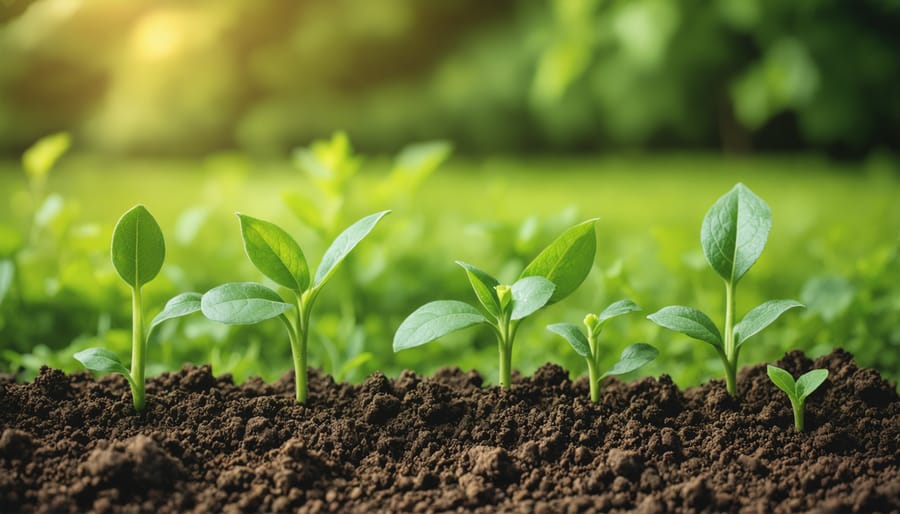
Water Management in Alberta’s Variable Climate
Alberta’s unpredictable weather patterns—from sudden spring frosts to prolonged summer droughts—make water management one of your most challenging decisions. Digital twin simulations are helping prairie farmers optimize irrigation schedules by analyzing soil moisture data, weather forecasts, and crop water requirements in real-time.
Take the example of organic grain producers near Lethbridge who’ve reduced water usage by 23% while maintaining yields. Their digital twin integrates historical precipitation patterns with current soil conditions to predict optimal irrigation timing, preventing both water stress and overwatering that can lead to disease pressure.
For drought resilience planning, these simulations model various climate scenarios months in advance. You can test different crop rotations, cover crop strategies, and water conservation practices virtually before committing resources. The technology accounts for Alberta-specific factors like chinook winds and rapid temperature swings that affect soil moisture retention.
While initial setup requires investment in soil sensors and weather stations—typically $3,000-$8,000 depending on farm size—many producers report the water savings alone justify costs within two growing seasons. Regional agricultural extension services are increasingly offering workshops on interpreting simulation data for practical water management decisions.

Tracking Your Carbon Footprint Progress
One of the most compelling benefits of digital twin technology is its ability to track and document your carbon sequestration efforts with precision. For organic farmers pursuing certification through programs like Alberta’s Agricultural Carbon Offset System, these simulations provide the detailed data needed to verify your environmental impact.
Digital twins can calculate how much carbon your soil management practices capture annually, measured in tonnes of CO2 equivalent per hectare. This quantifiable data becomes powerful when communicating with buyers who prioritize sustainable sourcing or when applying for environmental grants. Several Alberta farmers have successfully used simulation data to demonstrate their carbon-negative operations to organic food distributors, opening up premium market opportunities.
The technology also tracks your progress over time, showing how changes in practices—like increased cover cropping or reduced tillage—affect your carbon balance. You’ll receive visual reports that make complex data accessible, helping you refine your strategies and celebrate milestones. For farmers interested in carbon credit markets, this documented proof becomes essential. The system creates an auditable record of your environmental stewardship, turning your sustainable practices into verifiable assets that strengthen your farm’s reputation and potentially generate additional revenue streams.
The Honest Challenges and Limitations
Let’s be upfront: digital twin technology isn’t a magic solution, and it comes with real challenges that deserve honest discussion.
**Infrastructure and Access**
Rural internet connectivity remains the elephant in the barn. While digital twins can function with periodic data uploads rather than constant streaming, reliable internet access is still essential. Many Alberta farms, particularly in remote areas, face connectivity limitations that make real-time monitoring difficult. The good news? Technology is catching up—satellite internet options are expanding, and some systems now offer offline functionality with batch synchronization.
Initial setup requires both time and patience. You’re looking at weeks, not days, to properly calibrate sensors, establish baseline data, and train the system to understand your specific farm conditions. There’s a learning curve involved, and it’s steeper for some than others.
**Understanding the Technology’s Limits**
Here’s the critical point: digital twins create models, not crystal balls. They predict based on available data and algorithms, but they can’t account for every variable nature throws your way. An unexpected hailstorm, a new pest variant, or microclimatic conditions your sensors don’t capture can all affect outcomes differently than predicted.
Dr. Sarah Chen, agricultural technology specialist at the University of Alberta, puts it clearly: “Digital twins are decision support tools, not decision-making tools. The farmer’s knowledge and intuition remain irreplaceable.”
**Data Privacy and Control**
Data ownership is non-negotiable. Your farm data is valuable intellectual property. Before adopting any system, ensure you understand who owns your data, how it’s stored, where servers are located (Canadian data sovereignty matters), and whether information is shared or sold to third parties.
Look for platforms offering transparent data agreements and farmer-controlled permissions. You should maintain complete authority over what data is collected, how it’s used, and who can access it.
The technology shows genuine promise, but enter with eyes wide open and expectations realistic.
Digital twin simulation represents more than just another tech trend—it’s a natural evolution of the careful observation and adaptive management that organic farmers have practiced for generations. By creating virtual models of your fields, you’re essentially scaling up the same intuition and knowledge that comes from walking your land daily, but with added precision and predictive power.
The beauty of this technology is that it works *with* natural systems rather than against them. Whether you’re tracking beneficial insect populations, optimizing cover crop rotations, or fine-tuning your composting schedule, digital twins help you make decisions that honour the complexity of living soil ecosystems.
Starting your digital twin journey doesn’t require a complete farm overhaul. Begin with a single field facing a persistent challenge—perhaps a section with drainage issues or inconsistent yields. Partner with organizations like Agriculture and Agri-Food Canada or your provincial agricultural extension services, many of which are piloting digital agriculture programs specifically for small and medium-sized operations. Alberta’s Olds College and the University of Guelph regularly offer workshops on precision agriculture technologies adapted for organic systems.
Connect with other farmers already experimenting with these tools through local organic farming associations or regional innovation networks. Their experiences—both successes and setbacks—will prove invaluable as you navigate your own implementation.
You’re not just adopting new technology; you’re joining a movement of farmers who are proving that sustainability and innovation go hand in hand. By thoughtfully integrating digital twins into your operation, you’re helping write the next chapter of Canadian agriculture—one that’s both productive and regenerative, tech-enabled yet deeply rooted in ecological principles.

